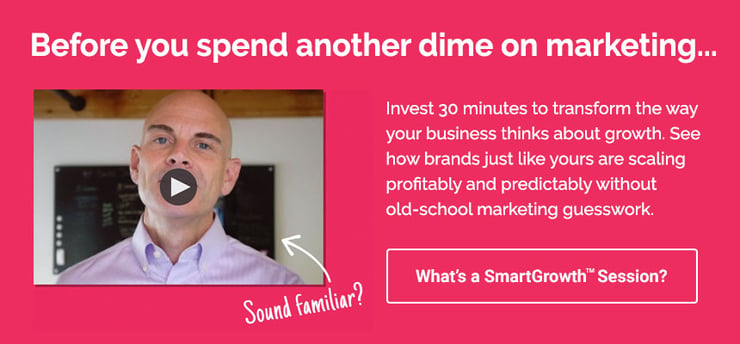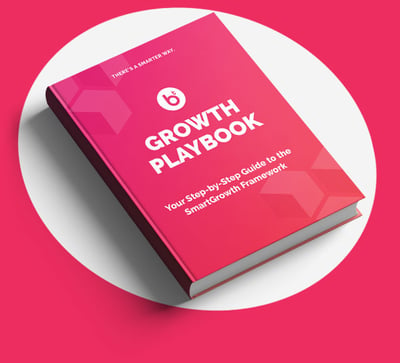What are the top reasons SaaS startups fail? Poor product market fit, lack of product differentiation, and running out of cash are the most notorious causes. And although these pitfalls may be well-known, the start-up failure rate is still a staggering 90%.
The good news? Nearly all of these can be addressed by creating a solid foundation for your marketing and messaging strategy and by aligning your digital marketing efforts with the SaaS growth stage of your company.
In this article, we’ll walk you through the best digital marketing tactics for each growth stage of your SaaS business to help ensure that you’re creating predictable and profitable growth from the beginning.
Digital Marketing for SaaS: Priorities for Each Growth Stage
Your company’s marketing needs will change as you move from inception to product-market fit and ultimately to exponential growth. The primary strategies that serve you as you are establishing your brand and building awareness will likely become secondary to other strategies more tailored to nurturing an existing audience, encouraging referrals, and re-selling or cross-selling once you have loyal customers. Aligning your growth stage to your digital marketing strategy will ultimately save you time and money, and also make your marketing efforts more successful right out of the gate.
Stage 1: Establishing Product-Market Fit
This is the stage where it can be highly tempting to just dive into digital marketing or a website redesign without a plan.
Don’t do it.
Before you rebuild your website, pay for search ads or to boost social media posts, it’s important to get really clear on who you are, who you are trying to reach, what problem your software solves, and how it is different from (i.e. superior to) the alternative solutions. In marketing speak, this is also known as creating a brand value proposition. Creating a BVP is an exercise that helps you clearly elucidate the specifics of what your product does, who it helps, how it helps them, and what problems/difficulties it prevents them from experiencing.
The next step is getting to know your target audience and understanding their ‘jobs to be done,’ often by creating buyer personas – fictionalized characters that represent different ideal customers, so you can tailor your messaging directly to them. And finally, who are your competitors? What are their strengths and weaknesses? How does your solution differ? Consider not just your direct competitors (similar software) but also alternative solutions that aren’t under the SaaS umbrella.
Notice how we haven’t actually begun marketing yet? Stay with me. We’re building the foundation for a successful strategy. Because for both effective digital marketing and establishing product-market-fit, it’s vital to understand your end users.
Once you have a crystal clear picture of your ideal customers, your competition, and how your product fits within the greater marketplace – only then do you begin. First by building awareness, then focusing on customer acquisition and lead generation. Armed with the knowledge of where your potential customers spend time online, what problems they need to solve, and how your product outshines the alternatives, your messaging, graphics, and channels can be tailored to these specific personas, making it much more likely that the right buyer is going to see and resonate with your efforts.
Now it is time to consider re-designing your website with a growth marketing mindset. Now is also the time to begin producing consistent, valuable, and SEO-driven blog content on your website that you can repurpose on social media, and again as a video or webinar. Paid search and paid social ads can also be immensely beneficial for building awareness and acquiring customers because both channels allow brands to target specific audiences.
As you build quality traffic to your website, make sure to incorporate lead magnets and other lead generation tactics into your site structure via calls-to-action, landing pages, forms, and gated content that can keep prospects moving into and through your sales funnel. Again, all of these should be customer-centric and geared towards addressing your ideal buyers’ problems and overcoming whatever obstacles might stand between them, and committing to your solution.
Stage 2: Develop a Repeatable & Profitable Sales Process
You’ve built a solid foundation and are seeing some great marketing-qualified leads (MQLs) roll in from your stage one effort. The next step in your SaaS digital marketing strategy is to develop a repeatable and profitable sales process by aligning your marketing and sales activities, leveraging automation, capitalizing on email nurture campaigns, and lead scoring.
Sales and marketing alignment refers to the obvious, but often overlooked, fact, that it’s vital for your sales and your marketing teams to be on the same page. Your sales folks should be intimately familiar with your ideal customer, the types of content and messaging that the marketing team is producing, and what combination of messaging, platform, and target audience is generating MQLs. Likewise, marketing teams benefit from hearing from the sales team about customer feedback, potential user experience or interface issues, and who they are losing business to when leads fail to become customers. Sharing data like marketing KPIs is essential but so are regular meetings and inter-department emails or Slack channels.
Leveraging automation involves taking advantage of CRM platforms like Hubspot or Salesforce to capture and organize leads as they come in through your website or social media channels. These platforms streamline the customer onboarding process through triggered actions. For example, if a customer provides their name and an email in order to download a template, that information goes into a database, the sales team is notified that there’s a new MQL in the pipeline, and then that same person might get added to a three-part email nurture sequence to engage them further. All of this happens automatically, without anyone lifting a finger. Smart.
Finally, lead scoring refers to “scoring” each lead with a numerical value corresponding to the likelihood of that lead becoming a customer. It is a data-driven approach to helping your marketing and sales teams better understand which leads are serious, and which might just be browsing. Lead scoring models can be based on demographics, online behavior, and email and social media engagement, among others. How you score leads will be determined by looking back at the common traits or behaviors your existing customers displayed prior to converting. This information will help define what makes a new lead more or less likely to convert.
Stage 3: Scale
You’ve established a consistent sales process and your stage one and two digital marketing efforts are paying off. Now you are poised to accelerate your company’s growth by investing in expanding your team efficiently and scaling up your business steadily and predictably. At this stage, being attentive to churn rates - the rate at which existing customers are failing to renew - and monitoring KPIs becomes a top priority.
Marketing analytics, specifically the so-called Pirate Metrics framework developed by Dave McClure, are tailored to product-led growth companies like SaaS. They include awareness, acquisition, activation, retention, referral, and revenue, or AAARRR. These metrics mirror the SaaS sales funnel and help savvy startup founders see where their marketing and sales efforts are running smoothly and where things may get stuck. This feedback is invaluable to keeping leads coming in, converting, sticking around, and even becoming advocates for the brand. It also lets your marketing and sales teams know which strategies are most effective and which are underperforming, helping guide future marketing and sales endeavors toward greater efficiency and success.
Ready to invest in Digital Marketing for your SaaS Company?
Aligning your digital marketing strategy with your SaaS growth stage helps ensure that you can validate what is working before growing too quickly and burning through capital. While digital marketing is key to successful SaaS startups, jumping into marketing without building the right foundation is a surefire way to waste time and money. Rather, early-stage SaaS companies would do better to align their marketing efforts with their current goals based on where they are in terms of growth as a company.
Poised to dive into digital marketing? Want to be sure your time, money, and resources don’t go to waste? As a growth marketing company, Brand Theory helps SaaS companies develop from start-up to scale-up. We work with them to understand their ideal customer, parse their unique value proposition and differentiate from their competitors BEFORE we launch into marketing services. Ready to grow profitably & predictably? Book a free, no-obligation, one-on-one session today.




.png)
.png)
.png)
